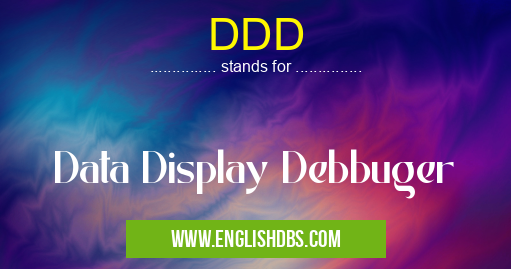What does DDD mean in UNCLASSIFIED
DDD stands for Data Display Debugger. It is a graphical frontend for the GNU debugger (GDB), providing a user-friendly interface to debug C and C++ programs. DDD allows users to inspect variables, set breakpoints, step through code, and visualize data structures. It is widely used by programmers for debugging complex software applications.

DDD meaning in Unclassified in Miscellaneous
DDD mostly used in an acronym Unclassified in Category Miscellaneous that means Data Display Debbuger
Shorthand: DDD,
Full Form: Data Display Debbuger
For more information of "Data Display Debbuger", see the section below.
Features of DDD
- GUI-based interface: DDD provides a graphical user interface (GUI) that makes debugging easier and more intuitive. Users can navigate the program's code, set breakpoints, and inspect variables using a point-and-click interface.
- Variable inspection: DDD allows users to inspect the values of variables at any point during program execution. It provides a hierarchical view of the program's data structures, making it easy to understand the relationships between different variables.
- Breakpoint management: DDD allows users to set breakpoints at specific lines of code. When a breakpoint is hit, the program execution is paused, allowing users to inspect the state of the program and identify potential issues.
- Step-by-step debugging: DDD provides step-by-step debugging capabilities, allowing users to execute the program one instruction at a time. This is particularly useful for understanding the flow of execution and identifying the exact point where an error occurs.
- Visualization of data structures: DDD can visualize complex data structures, such as arrays and linked lists. This helps users understand how data is organized and manipulated within the program.
Essential Questions and Answers on Data Display Debbuger in "MISCELLANEOUS»UNFILED"
What is Data Display Debugger (DDD)?
DDD is a graphical user interface (GUI) debugger for C, C++, Python, and Fortran programs. It provides a powerful and intuitive interface for inspecting variables, setting breakpoints, and stepping through code.
What are the key features of DDD?
DDD offers a wide range of features, including:
- Graphical representation of data structures
- Interactive variable inspection and modification
- Conditional breakpoints and watchpoints
- Call stack and local variable browsing
- Support for multiple programming languages
- Customizable interface and plugins
How can I use DDD to debug my code?
To use DDD, you need to first compile your code with debugging information enabled. Then, you can launch DDD and open your executable file. Once the program is loaded, you can set breakpoints, inspect variables, and step through your code to identify any issues.
What are the advantages of using DDD over other debuggers?
DDD offers several advantages over other debuggers, including:
- Its graphical interface makes it easy to visualize complex data structures and program flow.
- It is language-agnostic, supporting multiple programming languages.
- Its customizable interface and plugin system allow you to tailor it to your specific needs.
Is DDD free to use?
Yes, DDD is free and open-source software licensed under the GNU General Public License (GPL).
Final Words: DDD is a powerful tool for debugging C and C++ programs. Its GUI-based interface, variable inspection capabilities, breakpoint management, and data structure visualization features make it an essential tool for any programmer working with complex software applications. By leveraging the capabilities of DDD, developers can quickly and effectively identify and resolve bugs, improving the quality and reliability of their code.
DDD also stands for: |
|
| All stands for DDD |
